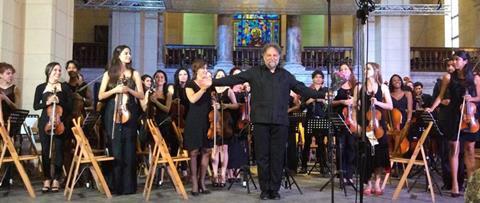Walter Reiter discusses how the rhetorical narrative in Baroque music must be reflected in how players use the bow, illustrating the parallels between spoken word and string playing

Photo: Linda Perillo
Walter Reiter conducts the Orchestra of the Lyceum Mozartiano in Havana, Cuba, in 2016
Explore more Featured Stories like this in The Strad Playing Hub
The following extract is from The Strad’s September 2021 issue feature on historically informed performance. To read it in full, click here to subscribe and login. The September 2021 digital magazine and print edition are on sale now
The connection between rhetoric, the art of persuasion and music is well documented from the time of the ancient Greeks. Bach himself studied Aristotelian rhetoric at school and among the books he left in his will were several on that subject. In his solo violin and cello music, there are few movements that can be said to be purely melodic: the rest are either dances or dance-inspired, or they are based on rhetoric.
Mistaking the rhetorical narrative for a coherent melody, in which the fragments are ironed out by a singing legato bowing and smothered in a continual vibrato, is to diminish the intensity of the music and its power to ‘affect the mind and command the passions’ of the listener. Rhetorical music therefore needs to be played in a rhetorical way: not to do so is to mistake the recitative for the aria!
Playing words: the deconditioning of the right arm
No mention is made of actual bow strokes in the historical sources. Players would constantly and imaginatively conjure up sounds from the plethora of available articulations, from the shortest to the longest, from the stressed to the deliberately underplayed. Bow technique on the ‘modern’ violin is broadly based on methodical practice and application of abstract bow strokes categorised by Viotti and others in the early 1800s. One such is détaché, a vague term but one too often taken to mean a stroke so even, smooth and regular that relatively little rhetorical subtlety is possible. It is significant to what extent students find it challenging to replicate the nuances of spoken language, yet it is here that the secret of rhetorical bow technique is to be found.
As an exercise, I get the student to speak a word such as ‘Michelangelo’ or a phrase like ‘Kyrie eleison’ in the manner of an orator, observing its elusive rhythms, stresses, consonants and expressive vowel sounds. The challenge is to replicate their voice (once it has become convincingly theatrical) with the bow, on an open string. The tendency is usually to downgrade the rhythm to one that is easy to identify, thereby stripping it of its subtle nuances. A vowel will always have some degree of dynamic scheme inherent in it, something that will keep the sound alive and expressive. Singers do this naturally. Try singing ‘Kyrie eleison’ yourself: you will find that every syllable has some degree of swell (<>). This expressive swelling of the sound, well documented throughout the Baroque period, continued to be applied in string playing until the fashion for a continuous vibrato took over in the 20th century.
Read: Historically informed performance: Baroque revolution
Read: Beyond Bach: 12 tips for better Baroque playing
Discover more Featured Stories like this in The Strad Playing Hub



































No comments yet